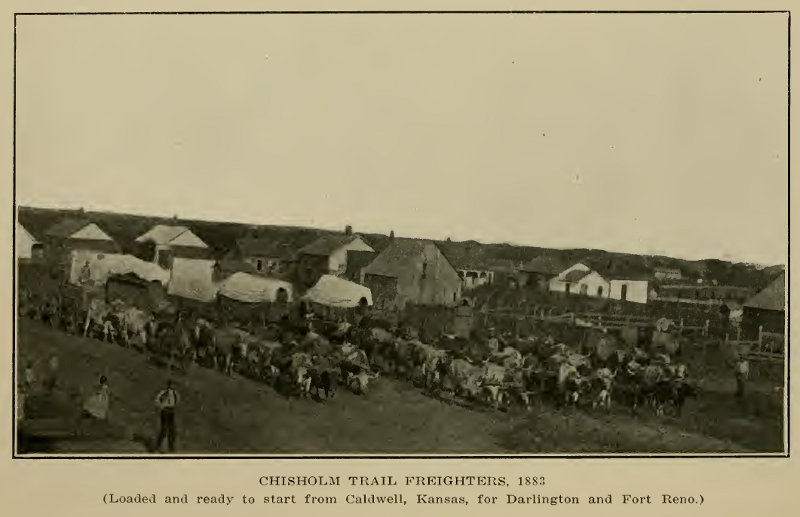 |
| SEVENTH PERIOD |
| (1875-1889) |
| STRUGGLE FOR SETTLEMENT. |
| The Extermination of the Buffalo. —The building of railways westward from the Missouri River, across the Great Plains, to the Rocky Mountains, led to the rapid killing of the mighty herds of the American bison, or buffalo, which once grazed over the vast region. They were killed by |
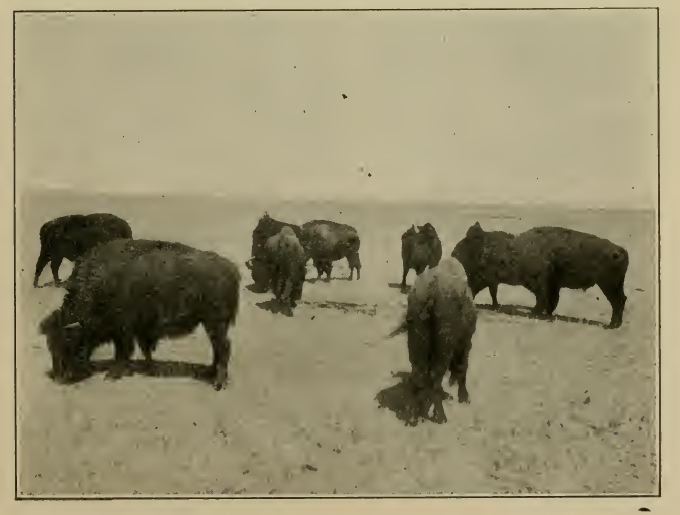 |
| BUFFALO ON THE GREAT PLAINS |
| the thousand merely for their hides. Thousands were also shot down for the mere wanton “sport” of killing. The killing of the buffalo in such numbers was one of the principal causes of the last Indian wars on the Plains. when the buffalo had all disappeared, the Indians could no longer roam at will over the Plains, for they had depended upon the buffalo for food, clothing and shelter. The disappearance of the buffalo made way for the flocks and herds and cultivated fields of the white settlers. |
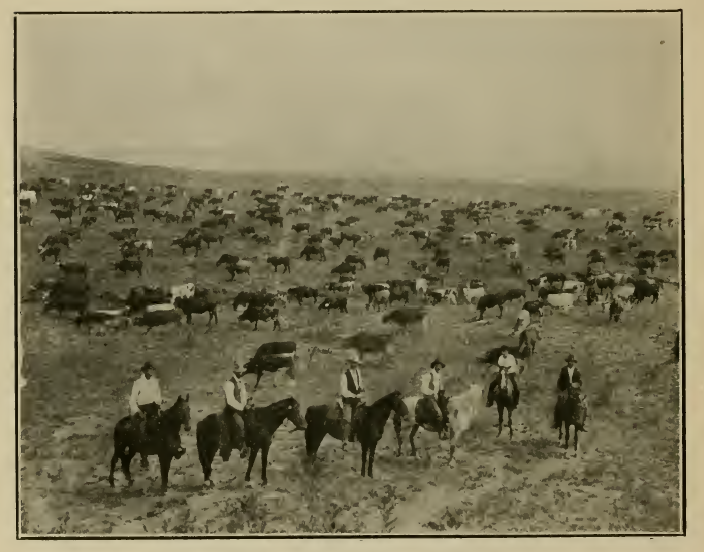 |
| A HERD OF RANGE CATTLE |
| The Range Cattle Industry. —When the buffalo herds had about disappeared and the Indians had settled down to a quiet life on their reservations, the cattlemen crossed different parts of the Indian Territory, slowly grazing their herds northward toward the railroads in Kansas. The rich native grasses upon which the buffalo had grazed, still grew abundantly. The cattlemen were not slow to note the opportunity for their line of business in such a promising field. Soon cattle ranches began to appear, lands being leased on the Indian reservations at a few cents per acre. Lands not included in any Indian reservation were quietly occupied without waiting for permission. During the years between the close of the last general Indian outbreak (1875), and the beginning of the agitation for the opening of Oklahoma to settlement, (1879), cattle ranges had been established in many parts of the western half of the Indian Territory. |
| More Indians Removed to Oklahoma. —During the first four years of this period several additional tribes of Indians were removed to the Indian Territory from other states or territories. Among these were the Pawnee and Ponca tribes, both of which were from Nebraska, the Northern Cheyennes (from Wyoming), and the Nez Perce (na-par-sa) from Oregon. The last two mentioned tribes were brought to the Territory after having surrendered as prisoners of war. In September, 1878, a band of 300 Northern Cheyennes, under the leadership of a chief named Dull Knife, left the Cheyenne reservation in Western Oklahoma and went northward on the warpath. Several ranchmen were killed by them in Northwestern Oklahoma. |
| Proposed Organization of the Indian Territory. —In January, 1879, Senator Stephen W. Dorsey, of Arkansas, introduced a bill into Congress, the purpose of which was to organize the Indian Territory. The five civilized tribes entered a vigorous protest against the passage of the measure. It did not become a law. |
| The Unassigned Lands. —That part of the lands ceded to the United States by the Creek and Seminole nations (by treaties of 1866) which was bounded on the north by the Cherokee Strip, on the east by the Indian Meridian, on the south by the South Canadian River, and on the west by the Cheyenne and Arapaho reservation, was never assigned to any Indian reservation. This tract, which embraced portions of Payne, Logan, Oklahoma, Cleveland, Canadian and Kingfisher counties, was the one on which all the intruding colonies of “boomers” proposed to locate in the various invasions which occurred between 1879 and 1885. |
Attempted Settlement of Oklahoma. —In April, 1879, it was announced that railway attorneys had discovered that there were 14,000,000 acres of land in the Indian Territory that belonged to the Government and that these lands were subject to homestead entry. This announcement caused a great deal of excitement. Companies of men were formed in Kansas, Missouri and Texas for the purpose of settling on the unoccupied lands in the Indian Territory. When the first colony of settlers arrived in the Indian Territory early in May, they w e r e promptly removed by United States troops. and that these lands were subject to homestead entry. This announcement caused a great deal of excitement. Companies of men were formed in Kansas, Missouri and Texas for the purpose of settling on the unoccupied lands in the Indian Territory. When the first colony of settlers arrived in the Indian Territory early in May, they w e r e promptly removed by United States troops.
Captain Payne Becomes the Leader. —The proposed settlement of the Oklahoma Country, as the unassigned lands of the Indian Territory had come to be called, continued to interest many people during the latter part of 1879 and the early part of 1880. Capt. David L. Payne had become the recognized loader of the movement to settle the Oklahoma Country. During the next five years, Payne led at least eight different -attempts to settle colonies in Oklahoma. He was often arrested but never tried. He appealed to the courts and once went to Washington where he appealed to the Secretary of the Interior. Though he was repeatedly driven out of the Territory, the Government always declined to prosecute him. His followers were generally called Oklahoma “Boomers.” |
| Organization of Cherokee Strip Live Stock Association. —March 6, 1883, the cattlemen of the Cherokee Strip held their third annual meeting at Caldwell, Kansas. This meeting resulted in the organization of the Cherokee Strip Live Stock Association, which duly incorporated under the laws of the state of Kansas. |
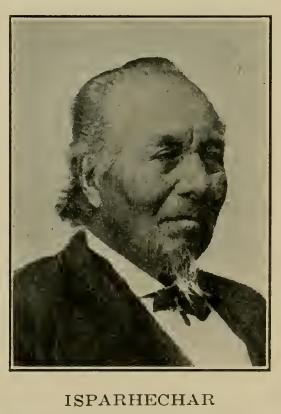 The Spiechee War.— In the fall of 1882, hostilities broke out between two factions or parties in the Creek Nation. Some of the followers of Opothleyohola, who had remained firm in their attachment to the Union twenty years before, under the leadership of Spiechee (or Isparhechar), rose in rebellion against the existing tribal government. A force of six hundred men was raised and placed under the command of Pleasant Porter, by Col. Samuel Checote, the principal chief of the Creek Nation. General Porter pursued the retreating band until it crossed the line into the Sac and Fox country. Spiechee led his people to the Wichita Agency. They refused to return to their homes in the Creek country until after the Government had insisted upon bringing about peace between the two parties. The Spiechee War.— In the fall of 1882, hostilities broke out between two factions or parties in the Creek Nation. Some of the followers of Opothleyohola, who had remained firm in their attachment to the Union twenty years before, under the leadership of Spiechee (or Isparhechar), rose in rebellion against the existing tribal government. A force of six hundred men was raised and placed under the command of Pleasant Porter, by Col. Samuel Checote, the principal chief of the Creek Nation. General Porter pursued the retreating band until it crossed the line into the Sac and Fox country. Spiechee led his people to the Wichita Agency. They refused to return to their homes in the Creek country until after the Government had insisted upon bringing about peace between the two parties.
Additional Federal Court.— Early in 1883, Congress passed an act providing that the United States courts at Paris, Texas, and Wichita, Kansas, should have jurisdiction over parts of the Indian Territory. Up to that time, all cases in the Federal courts from the Indian Territory had been tried at Fort Smith, Arkansas. |
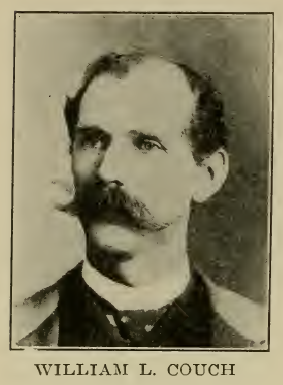 Couch Succeeds Payne. —After the death of Capt. David L. Payne, William L. Couch, who had been one of Payne’s most trusted lieutenants, became his successor as the leader of the “boomers.” During the following twelve months, several more efforts were made to colonize the Oklahoma country. After Congress first took up the question of opening Oklahoma for settlement (December, 1884), the interest in the “boomer” movement died out and no further organized efforts were made to settle in Oklahoma after 1885 until the country was opened to settlers by law in 1889. Couch Succeeds Payne. —After the death of Capt. David L. Payne, William L. Couch, who had been one of Payne’s most trusted lieutenants, became his successor as the leader of the “boomers.” During the following twelve months, several more efforts were made to colonize the Oklahoma country. After Congress first took up the question of opening Oklahoma for settlement (December, 1884), the interest in the “boomer” movement died out and no further organized efforts were made to settle in Oklahoma after 1885 until the country was opened to settlers by law in 1889.
Threatened Indian Outbreak —In the spring of 1885 many of the Cheyenne Indians became restless and were reported to be buying, and secreting arms and ammunition. The repeated attempts of the “ boomers” to settle in Oklahoma and the presence of the stock men in the Indian country probably were the real causes of the trouble. About the middle of the following July, the stories of an Indian outbreak which was believed to be about to take place, caused the Government to assemble 5,000 troops in the Indian Territory and Southern Kansas. Gen. Philip H. Sheridan, who came from Washington,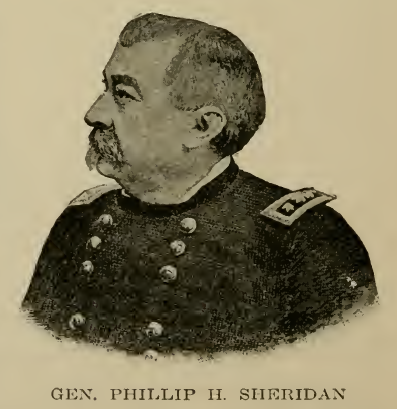 investigated the causes of the trouble and recommended that the cattlemen be required to remove their stock from the Cheyenne and Arapaho reservation. This was done. The expected outbreak never occurred. investigated the causes of the trouble and recommended that the cattlemen be required to remove their stock from the Cheyenne and Arapaho reservation. This was done. The expected outbreak never occurred.
Railway Construction.—The Atchison, Topeka & Santa Fe Railway Company built a line from Wichita to Caldwell, Kansas, in the spring of 1880. Caldwell was on the line of the old Chisholm Trail, so the overland cattle trade from Texas, as well as from the ranches and ranges of the western part of the Indian Territory, centered at Caldwell for a number of years. In 1884, the Santa Fe also planned to build a line southward from Arkansas City, Kansas, to Fort Worth, Texas. This line was built in 1885-6. The St. Louis & San Francisco Railway built a line southwestward from Fort Smith, Arkansas, to Paris, Texas, about the same time. In 1887-8 the Santa Fe also constructed a line southwestward from Kiowa, Kansas, to Amarillo, Texas. |
| Opposition to the Opening of Oklahoma. —The opposition to the opening of the vacant public lands of Oklahoma to settlement came principally from two sources, namely, the cattlemen who had ranches in the Territory, and the Indians, who naturally wished to be let alone in their own country. The Oklahoma question continued to attract much attention both in the West and in Washington, where it was before Congress every session. |
| No-Man’s-Land and Cimarron Territory. —In 1886 and 1887, large numbers of people settled in No-Man’s-Land. That region was not then attached to any state or territory. In the spring of 1887, the settlers organized a territorial government, selected temporary officers and chose a delegate to Congress. While this movement never received the approval of Congress, it aided in gaining recognition for the Oklahoma question. |
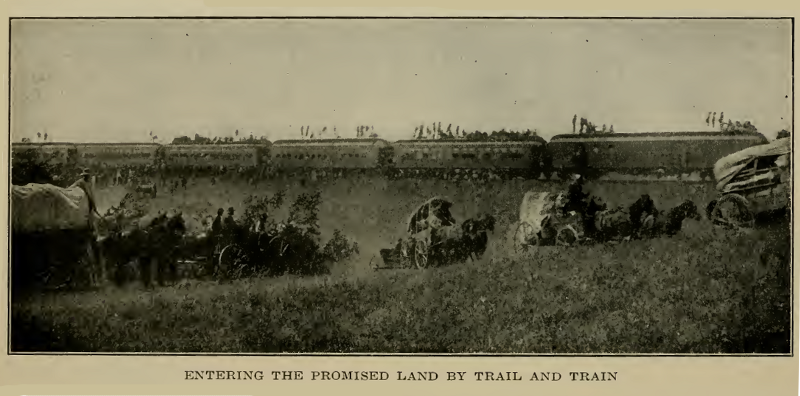 |
| The Oklahoma Question in Congress. —When the Fiftieth Congress convened in December, 1887, the Oklahoma Bill was again introduced. During the winter and spring of 1888 it occupied much time and attention. No action having been taken during the first session, the final contest came during the second session, in the winter of 1888 and 1889. After a hard fight, the Oklahoma Bill passed the House of Representatives, early in February, 1889. It was defeated in the Senate. The Oklahoma “boomers” in Washington, like those who had so long camped in wagons on the border, were defeated but not discouraged. They promptly tacked a "rider" on the Indian Appropriation Bill which provided that the lands of the so-called Oklahoma Country should be opened to settlement. The Senate was forced to accept the measure in that form. It provided also for the establishment of townsites and land offices but made no provisions for the organization of a territorial government. By the terms of this act, which became a law March 3, 1889, the president was to issue a proclamation giving thirty days’ notice of the proposed opening. |
| The Opening Day Proclaimed. —March 23, President Benjamin Harrison issued a proclamation setting the time of the proposed opening of the Oklahoma Country to settlement at noon on April 22d, 1889. For ten long years the agitation for the opening of Oklahoma had continued in spite of defeats, disappointments and discouragements that would have baffled any but the most determined of men. Success had at last crowned their efforts but at a cost in the way of patient endeavor, hardship and persecution which those who live in a later day can scarcely realize. |
| The Most Thrilling Event in Oklahoma’s History.
— Promptly at noon, April 22, 1889, the cavalrymen who patrolled the borders of the promised land, fired their carbines in the air as a signal that the settlers might move across the line. A mighty shout arose and the race for claims and homes began. Hundreds crowded the trains of the single railway line that entered Oklahoma, thousands rode on fleet horses lightly saddled, other thousands rode in buggies and buckboards, and yet others, in heavy farm wagons, drawn by slower teams, yes, and some even made the race on foot! The scene at the instant of starting was one never to be forgotten. It resembled the utter rout of a retreating army, rather than the orderly advance of an invading host. It was at once the culmination and climax of the story of American pioneering. |
| Summary. —Like those of the previous period, a large part of the events of historical importance which occurred in the Indian Territory, during the years between 1875 and 1889, transpired in the western part. The pioneering of the range cattlemen and the agitation and repeated invasions of the “boomers” adds additional distinctiveness to the history of Oklahoma, and will leave its mark on the life and institutions of its people. |
SUGGESTIVE QUESTIONS
Seventh Period. |
| 1. What event signalized the doom and disappearance of the mighty herds of buffalo from the Great Plains? What effect did this have upon the Indian? |
| 2. Tell the story of the range cattle industry in Oklahoma between 1875 and 1889. Why was the Cherokee Strip Live Stock Association organized? What part did this Association play during the agitation of the proposed settlement of Oklahoma? |
| 3. Briefly review the story of Capt. David L. Payne and the “boomers,” Recount the struggles of the "boomers" in their endeavors to secure homes in Oklahoma. What qualities manifested by the Oklahoma “boomer” are elements of strength in the building of a state? |
| 4. What were the Unassigned Lands? Where were they situated? |
| 5. When did the outbreak of the Northern Cheyennes occur? What causes led to the restlessness and threatened outbreak of the Oklahoma Cheyennes in 1885? |
| 6. Review the Spiechee War. |
| 7. Give a brief history of No-Man’s-Land. |
| 8. Briefly outline the contest in Congress between 1884 and 1889 for the opening of Oklahoma to settlement. By what means was the measure finally passed through Congress? |
| 9. When was the Oklahoma country opened to settlement? Tell the story of the settlement. |
| 10. What railroad building was done in Oklahoma during this period? |



 and that these lands were subject to homestead entry. This announcement caused a great deal of excitement. Companies of men were formed in Kansas, Missouri and Texas for the purpose of settling on the unoccupied lands in the Indian Territory. When the first colony of settlers arrived in the Indian Territory early in May, they w e r e promptly removed by United States troops.
and that these lands were subject to homestead entry. This announcement caused a great deal of excitement. Companies of men were formed in Kansas, Missouri and Texas for the purpose of settling on the unoccupied lands in the Indian Territory. When the first colony of settlers arrived in the Indian Territory early in May, they w e r e promptly removed by United States troops. The Spiechee War.— In the fall of 1882, hostilities broke out between two factions or parties in the Creek Nation. Some of the followers of Opothleyohola, who had remained firm in their attachment to the Union twenty years before, under the leadership of Spiechee (or Isparhechar), rose in rebellion against the existing tribal government. A force of six hundred men was raised and placed under the command of Pleasant Porter, by Col. Samuel Checote, the principal chief of the Creek Nation. General Porter pursued the retreating band until it crossed the line into the Sac and Fox country. Spiechee led his people to the Wichita Agency. They refused to return to their homes in the Creek country until after the Government had insisted upon bringing about peace between the two parties.
The Spiechee War.— In the fall of 1882, hostilities broke out between two factions or parties in the Creek Nation. Some of the followers of Opothleyohola, who had remained firm in their attachment to the Union twenty years before, under the leadership of Spiechee (or Isparhechar), rose in rebellion against the existing tribal government. A force of six hundred men was raised and placed under the command of Pleasant Porter, by Col. Samuel Checote, the principal chief of the Creek Nation. General Porter pursued the retreating band until it crossed the line into the Sac and Fox country. Spiechee led his people to the Wichita Agency. They refused to return to their homes in the Creek country until after the Government had insisted upon bringing about peace between the two parties. Couch Succeeds Payne. —After the death of Capt. David L. Payne, William L. Couch, who had been one of Payne’s most trusted lieutenants, became his successor as the leader of the “boomers.” During the following twelve months, several more efforts were made to colonize the Oklahoma country. After Congress first took up the question of opening Oklahoma for settlement (December, 1884), the interest in the “boomer” movement died out and no further organized efforts were made to settle in Oklahoma after 1885 until the country was opened to settlers by law in 1889.
Couch Succeeds Payne. —After the death of Capt. David L. Payne, William L. Couch, who had been one of Payne’s most trusted lieutenants, became his successor as the leader of the “boomers.” During the following twelve months, several more efforts were made to colonize the Oklahoma country. After Congress first took up the question of opening Oklahoma for settlement (December, 1884), the interest in the “boomer” movement died out and no further organized efforts were made to settle in Oklahoma after 1885 until the country was opened to settlers by law in 1889.